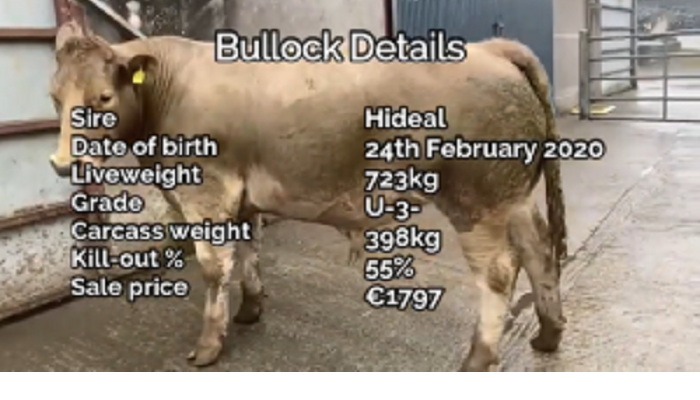22 November 2021
Earlier Finishing in Practice

Climate commitments through the Climate Action Plan are set to have a fundamental policy impact on beef production over the coming decades. Colm Kelly, Drystock Advisor, Teagasc Ballinasloe answers common questions about finishing cattle earlier and the challenges he has encountered.
Above Image: Results of individual bullock bred from an Aberdeen Angus x dairy suckler cow on Newford Demonstration farm Athenry.
Climate commitments through the Climate Action Plan are set to have a fundamental policy impact on beef production over the coming decades. Also within the market place across all sectors ‘green credentials’ are increasingly now a ‘condition of business’ to support marketing campaigns. These are likely the ‘push, pull’ factors that will shape what the future holds for all farmers. In this article I will answer common questions about one practice which is reducing slaughter age in cattle. This is on the back of references in the press about incentivising reducing average slaughter age from 27 to 24 months.
To finish cattle earlier will I need early maturing breeds?
Not necessarily, it is achievable to finish earlier with continental breeding. Animals that are more challenging to get good fat scores on tend to be very well muscled or exceptionally large framed animals that will take more finishing. There are likely genetic factors as well which mean certain bulls should be more suited to producing cattle for earlier finishing systems. Early maturing breed characteristics should favour a shorter finishing period and lower feed input but may not have the same carcase weight and grade potential. They also tend to be less efficient when finished indoors. Continental breeding trends towards longer finishing periods and higher feed inputs but generally will achieve better carcase weight and grade results. So both can work singularly or in balance if properly thought out and resources on the ground are taken into account. The lead in to the finishing period also has a significant impact. If the animals are on good quality grass prior to finishing or housing and in good condition this should reduce the finishing period also.
Will reducing slaughter age make financial sense?
To finish spring born cattle at 24 months will mean finishing out of the shed. In this case the feed input and housing costs are significant and require good silage quality, competitive feed sourcing and a strong beef price. This indoor feeding really requires high performance and good grades to make sense and for less specialised operators it is easy feed away your margin. Alternative options is to bring forward finishing to 18-20 months where a larger proportion can be finished off grass which reduces input and housing costs.
Where can I see earlier finishing?
Newford demonstration farm has been slaughtering spring 2020 cattle this autumn. These cattle are bred by 5 star terminal Limousin and Charolais bulls crossed on AA/HE x dairy suckler cows. On the 24th of September Newford slaughtered 18 beef heifers and achieved an average grade of R=3=. The average live weight was 572 kg with a carcase weight of 291 kg. The average sale price achieved was €1,295 at a group average 19 months of age. They were 208 days at grass where they had an ADG of 0.77 kg. The average feed input was 222 kg of a 12% crude protein ration during finishing which cost €68 per heifer with feeding starting on the 26th of July.
There has also been 9 spring 2020 bullocks slaughtered on the 18th of October. From the 2nd of September 2 kg of ration was introduced at grass which was built up to 5 kg. The bullocks averaged U-3- and a carcase weight of 372 kg from 697 kg live weight. From turnout to slaughter they averaged 1.01kg ADG. The group average was 194 kg of a 12% crude protein ration fed during finishing which came to €61 per animal with meal price €314/tonne. The average sale price for the 9 bullocks was €1,675. Newford demonstration farm produces regular updates which you can find online through ‘Teagasc Daily’ or other Teagasc online platforms and also on www.newfordsucklerbeef.ie
Any farmers trying finishing at 20 months?
Yes, I have come across cases where 20 month finishing is working out well. A big driver to actually try this system is farmers short of housing and frustration with having cattle that were ‘the wrong colour’ for the mart. Good weanling performance, good performance over the first winter and early turnout to decent grass in a rotational grazing system are the key markers enabling earlier finishing. A lot of performance can go missing on beef farms between weaning and housing or over the first housing period. The most challenging factor in finishing earlier is estimating fat score. If you are over cautious it can run cattle up to requiring additional housing while underestimating fat score can lead to significant cuts on price per kg achieved. It can be quite difficult to develop this skill and there is an element of learning from your mistakes.
If you liked this article you might also like to read Fluke Control – Product Choice and Timing Critical
Teagasc Advisors are regular contributors of articles here on Teagasc Daily. Find your local Teagasc office here
